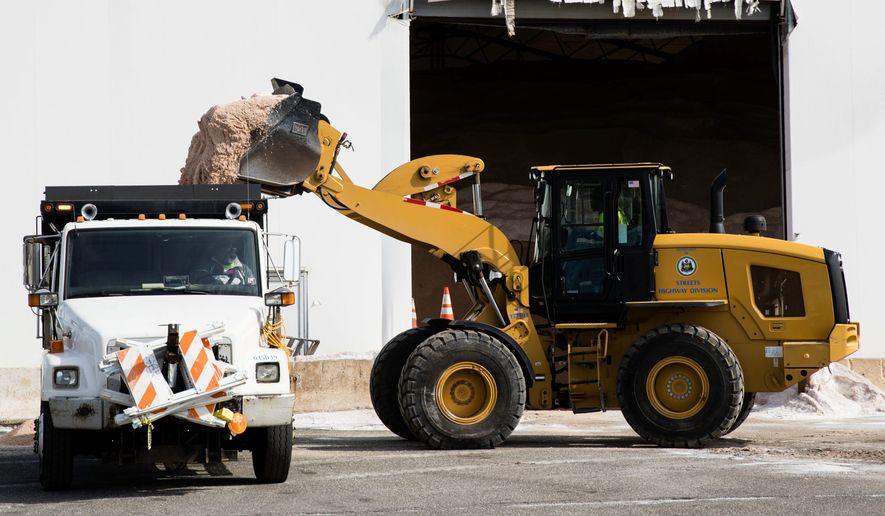Anybody driving around in the D.C. area’s first snowstorm of the season can thank a curious mix of rock salt, brine and beet juice for not slip-sliding away.
Road crews on Sunday began applying more than 30,000 gallons of the de-icing mixture, which creates a coating that bonds to street surfaces to prevent ice formation and aid melting, officials said. Beet juice or a similar sugar substitute helps lower the temperature at which water freezes.
“If we just laid rock salt on the road, [morning and afternoon] commuter traffic could wipe the rock salt to the side of the road,” said Christopher Short, director of the D.C. Department of Public Works. “When we include the liquid mix, place rock salt and then coat it with a liquid mix of brine and beet juice, it’s a coating to the ground and it lasts us for at least 72 hours. It can be effective for the first few inches of snow; the road temperature and the treatment will melt the snow.”
After having basked in what felt like an early spring, the D.C. region braced for a blast of winter as forecasters predicted a nor’easter would deliver a blizzard along the Northeast coast from Baltimore to New York City to Boston and beyond.
The National Weather Service said the D.C. area could receive 7 to 9 inches of snow.
Speaking at a press conference Monday, Maryland Gov. Larry Hogan said some people have been “lulled into a false sense of security because we got this great 70 degree weather, and I think everybody thinks it’s springtime. This is a serious winter storm.”
SEE ALSO: Global warmists brace for snow dump on climate change narrative
In Virginia, Gov. Terry McAuliffe declared a state of emergency Monday afternoon, and Pennsylvania Gov. Tom Wolf deployed members of the National Guard and announced travel restrictions ahead of the storm.
The Office of Personnel Management announced that it would decide at 4 a.m. Tuesday whether federal workers could take liberal leave because of the snow.
The storm even caught the attention of President Trump — on two fronts.
He met with D.C. officials Monday evening to discuss preparations for the storm. “Meeting w/ Washington, D.C. @MayorBowser and Metro GM Paul Wiedefeld about incoming winter storm preparations here in D.C. Everyone be safe!” he tweeted.
Earlier in the day, German Chancellor Angela Merkel delayed for two days her much-anticipated first visit with Mr. Trump. Presidential spokesman Sean Spicer announced at the daily press briefing that Ms. Merkel, who was supposed to be at the White House on Wednesday, will now meet with Mr. Trump on Friday.
Area school districts said they would decide early Tuesday whether to cancel classes and urged parents to check their websites and social media for the most up-to-date information.
Electric utilities Pepco and BGE said they had mobilized thousands of linemen to handle any power outages.
Metro officials said they expect to open the subway system at 5 a.m. and will run buses on a reduced service schedule. Any other service reductions will be announced early Tuesday. Metro Access for customers with disabilities was suspended Monday afternoon.
Officials at Baltimore-Washington International Thurgood Marshall Airport, Ronald Reagan Washington National Airport and Washington Dulles International Airport reported no delays on Monday. But airlines canceled as many as 4,000 flights on Tuesday. Amtrak canceled and modified service up and down the Northeast Corridor, and people were urged to stay off the roads.
A blizzard warning was issued for New York City and parts of northern New Jersey and southern Connecticut through much of Tuesday, with wind gusts of up to 55 mph and low visibility.
New York City could get up to 20 inches of snow. A similar amount is forecast for Boston, and Philadelphia is expected to get up to a foot.
In the D.C. area, the heaviest snowfall accumulations were expected northwest of Interstate 95 and in Northern Virginia.
Forecasters said rain could fall at times but most of the precipitation will be sleet or snow. Rain mixed with snow could fall east of I-95 approaching the Chesapeake Bay and across Southern Maryland.
Highway officials said the sleet and rain would not wash away the beet juice de-icing potion, which has the added benefit of reducing the amount of rock salt spread on city roads — thus lessening the effects of corrosion and toxic runoff.
“Across the country, jurisdictions who are interested in more environmentally conscious methods are beginning to use the liquid mix more often than they have in the past, and so we are moving in that direction,” said Mr. Short, the District’s public works director.
Road crews used the mixture throughout the relatively mild winter to guard against icy conditions. The Department of Public Works employs an in-house chemist who concocts a brine and then adds organic beet juice delivered from an outside supplier.
K-Tech Specialty Coatings in Indiana makes its own variant of the natural de-icer, and facility manager Brent Schrader says the company moved to a high quality beet-molasses mixture after finding that the simple juice tended to clog the de-icer.
Other creative solutions for increasing the effectiveness of rock salt include cheese brine, popular in Wisconsin for its abundance of dairies.
While local jurisdictions will continue to disperse the beet juice mixture on the road, authorities don’t recommend that civilians play chemist in their kitchens: Regular de-icing salt bought at the hardware store is the best bet for a safe walkway and driveway.
• Ryan M. McDermott, Dave Boyer and David R. Sands contributed to this article, which is based in part on wire service reports.
• Laura Kelly can be reached at lkelly@washingtontimes.com.




Please read our comment policy before commenting.